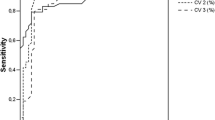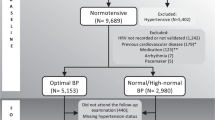Abstract
The aim of the study was to evaluate cardiac autonomic function and somatic sensation in healthy young adults with parental history of type 2 diabetes mellitus (T2DM). The study was conducted on 40 young adults with parental history of T2DM and 40 young adults without parental history of T2DM. The short term heart rate variability (HRV) and vibration perception threshold (VPT) were assessed in both groups. In time domain measures, standard deviation of all RR intervals (SDNN) [26.5 (22–33) vs 33.5 (25–37.75) ms, P = 0.014], the square root of the mean of the sum of the squares of differences between adjacent RR intervals (RMSSD) [25.85 (16.22–33.8) vs 30.9 (24.4–41.67) ms, P = 0.013], and percentage of consecutive RR intervals that differ by more than 50 ms (pNN50) [4.6 (1.1–13.77) vs 12.4 (2.8–26.82) %, P = 0.022] were significantly less in young adults with parental history of T2DM. In frequency domain measures, low frequency (LF) [115.5 (83.75–140.75) vs 141 (104.25–249.75) ms2, P = 0.021], high frequency (HF) [114.5 (74.5–179) vs 182.5 (104.25–247) ms2, P = 0.006] and HF [33.3 (24.52–53.22) vs 56.8 (43.02–69.17) nu, P = 0.002] were significantly less in young adults with parental history of T2DM. Whereas, LF [49.8 (36.97–69.55) vs 45.2 (35.4–57.02) nu] and LF/HF [0.98 (0.65–1.62) vs 0.85 (0.5–2.02) %] were comparable between the groups. VPT (for peripheral neuropathy) was comparable between the groups. This study indicates that parental type 2 diabetes has an impact on the cardiac autonomic function in non-diabetic young adults.
Similar content being viewed by others
References
Korf BR. Genetics in medical practice. Genet Med. 2002;4(6 Suppl):10S–4S.
International Diabetes Federation (IDF). [http://www.idf.org/types-diabetes]. Accessed May 9, 2013.
Pierce M, Keen H, Bradley C. Risk of diabetes in offspring of parents with non-insulin-dependent diabetes. Diabet Med. 1995;12:6–13.
Kobberling J, Tillil H. Empirical risk figures for first-degree relatives of non-insulin-dependent diabetics. In: Kobberling J, Tattersall R, editors. The genetics of diabetes mellitus. London: Academic; 1982. p. 201–9.
So WY, Ng MC, Lee SC, Sanke T, Lee HK, Chan JC. Genetics of type 2 diabetes mellitus. Hong Kong Med J. 2000;6:69–76.
Chan JC, Cheung CK, Swaminathan R, Nicholls MG, Cockram CS. Obesity, albuminuria and hypertension among Hong Kong Chinese with non–insulin-dependent diabetes mellitus (NIDDM). Postgrad Med J. 1993;69:204–10.
Lillioja S, Mott DM, Spraul M, Ferraro R, Foley JE, Ravussin E, et al. Insulin resistance and insulin secretory dysfunction as precursors of non–insulin-dependent diabetes mellitus. Prospective studies of Pima Indians. N Engl J Med. 1993;329:1988–92.
Task Force of the European Society of Cardiology and the North American Society of Pacing and Electrophysiology. Heart rate variability: standards of measurement, physiological interpretation and clinical use. Circulation. 1996;93:1043–65.
Young MJ, Jones GC. Diabetic neuropathy: symptoms, signs and assessment. In: Boulton AJM, editor. Diabetic neuropathy. Lancashire: Marius Press; 1997. p. 41–61.
Heatherton TF, Kozlowski LT, Frecker RC, Fagerstrom KO. The Fagerstrom test for nicotine dependence: a revision of the Fagerstrom Tolerance Questionnaire. Br J Addict. 1991;86:1119–27.
Baboor TF, Higgins-Biddle JC, Saunders JB, Monterio MG. AUDIT: the alcohol use disorder identification test: guidelines for use in primary care. 2nd ed. Geneva: World Health Organization; 2001.
Brennan M, Palaniswami M, Kamen P. Do existing measures of Poincare plot geometry reflect nonlinear features of heart rate variability? IEEE Trans Biomed Eng. 2001;48:1342–7.
Goit RK, Khadka R, Sharma SK, Limbu N, Paudel BH. Cardiovascular autonomic function and vibration perception threshold in type 2 diabetes mellitus. J Diabetes Complicat. 2012;26:339–42.
Goit RK, Paudel BH, Sharma SK, Khadka R. Heart rate variability and vibration perception threshold in type 2 diabetes mellitus. Int J Diabetes Dev Ctries. 2013;33:134–9.
Foss CH, Vestbol E, Froland A, Gjessing HJ, Mogensen CE, Damsgaard EM. Autonomic neuropathy in nondiabetic offspring of type 2 diabetic subjects is associated with urinary albumin excretion rate and 24-h ambulatory blood pressure: the Fredericia Study. Diabetes. 2001;50:630–6.
Forsblom CM, Kanninen T, Lehtovirta M, Saloranta C, Groop LC. Heritability of albumin excretion rate in families of patients with type II diabetes. Diabetologia. 1999;42:1359–66.
Faronato PP, Maioli M, Tonolo G, Brocco E, Noventa F, Piarulli F, et al. Clustering of albumin excretion rate abnormalities in Caucasian patients with NIDDM. The Italian NIDDM Nephropathy Study Group. Diabetologia. 1997;40:816–23.
Vinik AI, Maser RE, Mitchell BD, Freeman R. Diabetic autonomic neuropathy. Diabetes Care. 2003;26:1553–79.
Kleiger RE, Miller JP, Bigger Jr JT, Moss AJ. Decreased heart rate variability and its association with increased mortality after acute myocardial infarction. Am J of Cardiol. 1987;59:256–62.
Huikuri HV, Makikallio TH, Airaksinen KE, Seppanen T, Puukka P, Raiha IJ, et al. Power-law relationship of heart rate variability as a predictor of mortality in the elderly. Circulation. 1998;97:2031–6.
Cowan MJ. Measurement of heart rate variability. West J Nurs Res. 1995;17:32–48.
Fouad FM, Tarazi RC, Ferrario CM, Fighaly S, Alicandri C. Assessment of parasympathetic control of heart rate by a noninvasive method. Am J Physiol. 1984;246:H838–42.
Saeki Y, Atogami F, Takahashi K, Yoshizawa T. Reflex control of autonomic function induced by posture change during the menstrual cycle. J Auton Nerv Syst. 1997;66:69–74.
Park MK, Watanuki S. Specific physiological responses in women with severe primary dysmenorrhea during the menstrual cycle. J Physiol Anthropol Appl Human Sci. 2005;24:601–9.
Berger RD, Saul JP, Cohen RJ. Transfer function analysis of autonomic regulation. I. Canine atrial rate response. Am J Physiol. 1989;256:H142–52.
Kamen PW, Tonkin AM. Application of the Poincare plot to heart rate variability: a new measure of functional status in heart failure. Aust N Z J Med. 1995;25:18–26.
Brennan M, Palaniswami M, Kamen P. Poincare plot interpretation using a physiological model of HRV based on a network of oscillators. Am J Physiol Heart Circ Physiol. 2002;283:H1873–86.
Otzenberger H, Gronfier C, Simon C, Charloux A, Ehrhart J, Piquard F, et al. Dynamic heart rate variability: a tool for exploring sympathovagal balance continuously during sleep in men. Am J Physiol. 1998;275:H946–50.
Thomas F, Balkau B, Vauzelle-Kervroedan F, Papoz L. Maternal effect and familial aggregation in NIDDM. The CODIAB Study. CODIAB-INSERM-ZENECA Study Group. Diabetes. 1994;43:63–7.
Bo S, Cavallo-Perin P, Gentile L, Repetti E, Pagano G. Influence of a familial history of diabetes on the clinical characteristics of patients with Type 2 diabetes mellitus. Diabet Med. 2000;17:538–42.
Papazafiropoulou A, Sotiropoulos A, Skliros E, Kardara M, Kokolaki A, Apostolou O, et al. Familial history of diabetes and clinical characteristics in Greek subjects with type 2 diabetes. BMC Endocr Disord. 2009;9:12–8.
Festa A, D’Agostino Jr R, Hales CN, Mykkanen L, Haffner SM. Heart rate in relation to insulin sensitivity and insulin secretion in non-diabetic subjects. Diabetes Care. 2000;23:624–8.
Singh JP, Larson MG, O’Donnell CJ, Wilson PF, Tsuji H, Lloyd-Jones DM, et al. Association of hyperglycemia with reduced heart rate variability (the Framingham Heart Study). Am J Cardiol. 2000;86:309–12.
Panzer C, Lauer MS, Brieke A, Blackstone E, Hoogwerf B. Association of fasting plasma glucose with heart rate recovery in healthy adults: a population-based study. Diabetes. 2002;51:803–7.
Carnethon MR, Golden SH, Folsom AR, Haskell W, Liao D. Prospective investigation of autonomic nervous system function and the development of type 2 diabetes: the Atherosclerosis Risk in Communities Study, 1987–1998. Circulation. 2003;107:2190–5.
Carnethon MR, Jacobs Jr DR, Sidney S, Liu K. Influence of autonomic nervous system dysfunction on the development of type 2 diabetes: the CARDIA study. Diabetes Care. 2003;26:3035–41.
Mirsky IA, Futterman P, Broh-Kahn RH. The quantitative measurement of vibratory perception in subjects with and without diabetes mellitus. J Lab Clin Med. 1953;41:221–35.
Conflict of interest
The authors declare no conflict of interest.
Author information
Authors and Affiliations
Corresponding author
Rights and permissions
About this article
Cite this article
Goit, R.K., Paudel, B.H. & Khadka, R. Heart rate variability and vibration perception threshold in healthy young adults with parental history of type 2 diabetes mellitus. Int J Diabetes Dev Ctries 35, 593–597 (2015). https://doi.org/10.1007/s13410-014-0200-4
Received:
Accepted:
Published:
Issue Date:
DOI: https://doi.org/10.1007/s13410-014-0200-4




